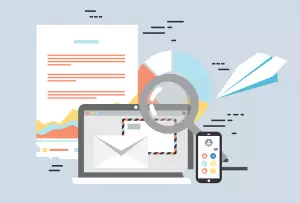A landing page is often the last thing a customer sees before arranging an appointment with a salesperson, downloading a free trial, requesting a demo or taking some other action.

Customers may arrive on your landing page by clicking a link on social media, a pay-per-click ad or other content and be persuaded to take the next step.
Effective landing pages can help you to collect important information from customers and increase your qualified leads and sales.
Why creating a dedicated landing page is important?
Your website homepage has many functions and people can navigate from the home page to other pages on your website.
Visitors to your website home page have distractions because it functions as your main hub and may contain a sidebar, links, videos etc.
A dedicated landing page enables visitors to accomplish a specific goal without any distractions.
By sending customers landing page links, they will visit your website more, engage better with website, develop more trust in your brand and be more responsive to what you have to offer.
What is a landing page?

When a visitor “lands” on your landing page, it serves a specific purpose.
For instance, a lead generation landing page typically offers “rewards” like a free trial, webinar registration, contest entry or free eBook in exchange for contact details.
All landing pages should deliver personalized, relevant offers that persuade customers to do what you want them to do.
Some benefits of a dedicated landing page
A landing page makes it very clear what will happen when a visitor clicks through. It is focused and free of any distractions. This makes the interaction straightforward and increases the chances of conversion.
Landing pages present a great opportunity to improve your SEO, increase your traffic, get qualified leads, improve conversions and build your brand.
They lead visitors to your offers, products or services and prompt them to take action.
You can create a number of different landing pages targeted at different segments of your audience to offer them what they want.
What is an Account Site?
You may prefer to make use of an Account Site on a video hosting platform to create video landing pages than building them without any support on all on your website.
Cincopa offers a 30-day free trial for an account site where you can create any number of landing pages that will all load easily and offer a quality experience for viewers. Here are the distinct features of an account site –
Customize format: You can use templates and customize them in the format that best suits your business for a landing page.
Clients have the option of adding their logo, brand statements, or adaptable colors to customize your pages. You don’t require coding experience to design, edit and deploy landing pages and there are even more options available for customization if you use CSS or HTML codes.
Get customers to take further action: Embedding a video on a landing page is easy. Visitors after watching the video can be encouraged to take some further action, such as requesting a demo, registering for a webinar, and more.
Modeling video landing pages as per your user funnel and using appropriate calls-to-action can increase conversions.
Customize domains: A CNAME (canonical name) feature with SSL certification allows you to customize domains in order to streamline your site hierarchy and enables users to navigate a website more easily.
You can point several subdomains to your main domain name by creating a CNAME. A subdomain can be unique to a team or department and you can link it to Google Analytics.
What makes landing pages successful?

The focused landing pages is a great tool for getting customers to take specific actions.
Research found that landing pages across industries have an average conversion rate of almost 10%.
It also found that the conversion rate varied depending on the industry and the features used on the landing page. For instance, something as simple as changing an image or a button color on a page as part of standard A/B testing could increase conversions.
What can hinder conversion rates? Another research showed that the highest conversion rates were achieved when fewer personal questions were asked on landing pages.
Most sign-up forms on video landing pages ask for a name and email address. Those that asked for details like birth dates or gender had fewer conversions.
Another reason for a lower conversion rate is if your website landing pages don’t load fast enough. With a shorter attention span, customers will quickly move on from the web page.
According to research, 30% of landing pages consist of too much text, which scares customers away.
Video content improves conversion rates: A survey has found that adding video content to a landing page is a great way to stop overwhelming customers with too much text and can improve conversions by as much as 86%.
Ways to improve leads: Research has found that having more landing pages can create more leads and conversions. By creating more landing pages, you can segment your traffic sources and appeal to different customers.
Having about 10 to 12 landing pages could improve leads by about 55%. The research also found that personalizing a landing page CTA to suit a customer offered better conversion rates.
While adding business contact details, such as a telephone number or address to a landing page can improve leads and conversions because this creates more consumer trust.
5 Steps to convert more from your dedicated Landing Page

Most landing pages ask visitors for sensitive information and you need to reassure them that providing such details is a good decision.
Proof of expertise and experience, social proof like testimonials and letting people know more about your company can help to build their trust.
The visibility and credibility of social proof on a landing page will lead to more conversions. Customer testimonial videos also work well as it builds more confidence with customers when they are making their decisions.
The longer a potential customers remain engaged with your landing page, the more likely they are to respond to a call-to-action.
By using visual content, you can increase their engagement, the time they spend on the page and your conversions.
Infographics, animations, and videos are all compelling elements to add to a landing page.
Customer interaction with landing pages has to be engaging and convenient if they’re to be receptive to what you have to offer. They must instantly understand the value you’re offering them rather than presenting them with a wall of text about the history of your company and its corporate values.
Customer satisfaction is also vitally important today and their needs should be one of the most important considerations when designing a landing page. You can’t afford to present any questionable claims or give customers irrelevant content on a landing page.
The 5 Steps to convert more from a dedicated landing page:
- Leverage a dedicated landing page for sales and customer support
- Leverage landing page for marketing on social media
- Manage your website audience
- Create lead generation forms on video
- Share videos directly from RecTrace
1. Leverage a dedicated landing page for sales and customer support
Customers who follow a link to a landing page want to know what’s in it for them.
Marketers and sales personnel need to understand their audience and anticipate their pain points to build compelling landing pages that appeal to customers.
Illustrating clearly how a product will fulfill their needs has to be done in a way that’s clear to understand and engaging.
Screen recorded videos: Adding video to landing pages can promote maximum engagement.
Screen recorded videos are easy to produce and teams can use them for various purposes, such as promoting products and educating customers.
Teams can record their screens and use a webcam to capture themselves talking for a more personal viewer and video experience. These personalized screen recorded videos offer the kind of authenticity that customers can connect with.
Sales reps using screen recording and webcam video often create more authentic videos than ones that are more expensive to produce.
Types of landing pages for marketing and sales
There are many different types of landing pages marketing and sales teams can use.
Landing pages can be click-through or lead visitors to other pages like a lead generation page or even to an e-commerce site.
- Squeeze Page
- Splash Page
- Lead Capture Page
- Click-through Landing Page
- Sales/Purchase Landing Page
- Dedicated Sales Staff Landing Page
- Customer Support Landing Page
Squeeze page: The intent behind a squeeze page is to obtain a user’s email address. It is short and uses gentle yet forceful persuasion on prospects.
Splash page: A splash page may not contain much copy but may have a striking video background or background image and a link directing visitors to your website. A splash page may not ask for any contact information but instead, convey important information like a company update.
Lead capture page: A lead capture landing page is basically a longer version of a squeeze page. An optimized lead capture form helps you to get leads related to your offer.
Both the length of the form and where it’s positioned can influence its success. The page offers rewards such as ebooks, white papers, free trials or demos in return for offering personal information.
When you offer something consumers value, you will convert more visitors into leads and capture information about who they are and what led them to convert.
A click-through landing page: This type of landing page provides value to visitors without asking them to buy.
It simply shares the type of information that can help to enhance their trust in your brand, which is a critical part of the sales process.
Sales/Purchase landing page: This is a long-form page that you could call a post-click landing page because it persuades prospects to make a purchase.
When it is used in the right way, it increases conversions. It should anticipate every objection prospective customers could pose and answer every question they may have so they have no reason not to buy.
Dedicated sales staff landing pages: When sales personnel each have a dedicated landing page, prospective customers can make contact with them, schedule a demo etc. Creating and sending their own personalized sales video messages can help to drive sales.
As you can see, different types of landing pages are suited to different stages of the sales funnel and videos can be used effectively on different types of landing pages.
A short explainer video on a landing page can show off your brand and tell visitors what they need to know in a digestible way without subjecting them to too much text. A how-to video on a landing page can be effective closer to the end of the funnel.
Customer support landing pages: A lack of customer support can quickly lead customers to a decision to jump ship. This is why excellent customer support is considered so important today and can offer you a competitive advantage in the marketplace.
To support customers in the best way, you will need to identify channels to communicate with them, use strategies based on their expectations, track conversions, analyze metrics and automate processes.
For instance, post-sales information videos can help customers to get the most out of their purchases. The team can screen record to show customers how to use certain features. It could share new product features on a dedicated page with a CTA.
2. Leverage landing page for marketing on social media
Social media can generate a great deal of traffic to a website. Sending people to the homepage of your website is not as effective as sending them to landing pages that fulfill a specific purpose.
You can create dedicated video landing pages suitable for specific social media channels by using templates while also designing pages suited to different audiences found on social media channels.
When you share a link on YouTube to a dedicated landing page on your account site, people may click it and go to it instead of staying on YouTube.
You can brand your landing page, add CTAs and easily track engagement on it on various social media channels.
Some videos can act as a prominent feature on landing pages and others work best together with persuasive copy.
An enticing thumbnail on a video typically offers higher engagement and consistency is important when adding any digital assets to a landing page. Videos must tie up with the offer on the landing page or its overall message and fit in with all the design elements.
There are no rules about the length of videos on landing pages, but it’s best to keep them short. Keeping videos above the fold usually ensures that they will get more engagement.
3. Manage your website audience
If you want full control over your landing pages as well as videos on them, using a video hosting platform offers you access to high-level privacy and security options.
You can manage access to your landing pages in a number of different ways.
For instance, you can get subscribers who can pay for specific gated content.
To protect your video assets on your landing pages, you can add an IP whitelist so videos will only play back on specific IP addresses.
This ensures that only employees connected to a company network can access and watch internal videos containing sensitive information.
By using domain lock, you can ensure that your videos can only be embedded on specific domains. Using password protection or email ids are other ways to protect your confidential data.
SSO (single sign-on) is another way to restrict access to specific videos, podcasts, or galleries. You can dedicate a landing page to a specific group of users and learn more about them in real-time.
A video hosting platform is a great way to manage audience and visitors on a landing page.
4. Create lead generation forms on videos
Calls-to-action, or CTAs, are essential on landing pages and they may consist of lead generation forms, download buttons, sign-up forms for newsletters, or buy now buttons.
CTAs are necessary to convert web traffic, social media engagement, and videos into leads. There are a number of ways to include CTAs in your video content on landing pages.
It requires some commitment from visitors to fill out a lead generation form and embedding it in a video can help.
If you want to grow your email list and send contacts straight to your CRM, you can show part of a video and, right before the most compelling part, introduce a lead capture form where viewers must enter a name and/or email address to keep viewing.
5. Share directly from RecTrace
Cincopa’s RecTrace is a free Chrome extension that allows team members to capture their screens on a Mac or Windows.
They can record a browser tab, an entire screen, or only the camera. Adding voiceovers and utilizing various other features such as annotations, subtitles, CTAs enhances them for lead generation and branding.
Once the videos are ready to share, it’s easy to do this directly from a Cincopa account site.
Why does Integration with Market Automation and CMS Platforms matter?

When your landing pages integrate with your marketing automation and CRM platforms, it creates the type of synergy you need for more effective marketing campaigns. People prefer to interact with visual content and marketers can personalize content to create more engagement and generate a better return.
Integration with a CRM means you can capture leads and score, segment and nurture your prospects.
When you have integration with your email marketing system, this also ensures that you can gain leads, score and segment prospects. Teams have access to an entire library of videos they can integrate into email campaigns.
With video conferencing integration, you can make sure that conferences, webinars etc., are saved and added to your video asset library for repurposing as video-on-demand (VOD).
Integrating with a customer support system makes communicating with customers and providing great support easier. You may be able to add all kinds of media, including videos, directly to customer tickets.
Integration with an ecommerce platform allows you to add media galleries to your ecommerce shop.
How Video Asset Management (VAM) can help you generate qualified leads
Video asset management involves creating, hosting, managing, enhancing, publishing and monitoring videos effectively. When all of these aspects are handled efficiently, videos can work optimally to generate qualified leads.
Videos help to create an emotional connection with visitors and make more complex products or services easier to understand.
With video asset management you get the following advantages:
Organization
When your video assets are managed and organized correctly, using them in your landing pages is much easier.
With VAM an organized library of video assets can be deployed in the right way at the right time to engage prospective customers and move them along in the sales funnel.
For instance, videos used in top-of-funnel landing pages can give a quick overview of the company, common industry pain points, and how a product can alleviate them.
“Get in touch” landing pages can benefit from specific product demos that serve as a teaser.
Advanced video analytics
See what videos viewers are watching, how much of a video they watched and whether they watched a certain part more than once.
You can get detailed analytics for the videos you embed on a landing page within a selected timeframe with VAM from a video hosting site.
Group stats are available by video file, domain, country, and web page. Individual stats include location, IP address, viewing time, average engagement, and platform.
Video heatmaps allow you to see how engagement changes during viewing. All of the advanced video analytics are available with video asset management.
Optimizing video landing pages
When you understand more about how your audiences interact with videos on your landing pages, you can work on optimizing them according to the insights you receive.
If your landing pages are delayed while loading, this can drive viewers away.
Using an account site from a professional video hosting platform can ensure your page loads immediately thanks to the use of a content delivery network (CND) with servers distributed worldwide.
A/B testing your videos on your pages with different video thumbnails, calls-to-action etc., can also lead to improvements that optimize conversions.
Conclusion
Creating a number of different types of landing pages that are optimized to attract traffic can improve your chances of qualified leads and conversions.
One of the key benefits of landing pages is that they have one singular function in mind and visitors can either take action or leave.
Making sure that the content on your landing pages is designed to appeal to consumer needs offers the best opportunity for conversions.









